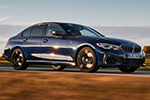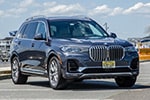It’s quite unusual for BMW to skip a model’s Life Cycle Impulse and jump straight to the next generation. Such is the case with the 2025 BMW 1 Series, with the F70 replacing the F40 that had been around for only about five years. Although it does look like an life cycle impulse model at first glance, the use of a different internal codename means the company considers it a true next-generation car.
Bigger Than Ever Before
As with just about every vehicle launched, the new 1 Series is bigger than its predecessor. It’s 42 mm longer (at 4361 mm) and 25 mm taller (at 1459 mm). It’s just as wide as before (at 1800 mm) and carries an identical wheelbase (2670 mm). Despite being slightly larger than before, you still get 380 liters of cargo capacity with the rear seats in place. Fold the bench and the volume jumps to 1,200 liters. Go for the 120 or 120d and practicality takes a hit, decreasing to 300 liters with the rear seats in the upright position and to 1,135 liters after folding them. The difference stems from the 48-volt battery mounted in the luggage area of the 120 and 120d that have mild-hybrid tech.
New Grille Design
Addressing the elephant in the room, the fourth-gen 1 Series has a rather peculiar front grille. The usual vertical slats are interrupted by angled bars that sort of look like the three lines in the ///M logo. However, BMW told us that’s not what they had in mind, but rather to come up with something fresh. The M135 xDrive has different kidneys, sporting horizontal bars similar to actual M cars from superior segments.
The polarizing grille is flanked by redesigned headlights with a matrix LED high-beam and blue inserts. Echoing other recent BMWs, those arrows double as the daytime running lights and turn signals. At the rear, the taillights are instantly recognizable since they’re largely derived from the new X2 crossover-coupe. There’s no visible exhaust on the normal 1 Series as only the M135 flaunts its quad tips.
The outgoing 1 Series had steel wheels in its basic configuration but its replacement gets a standard 17-inch alloy set. Customers can upgrade to 18- and 19-inch wheels, including forged aluminum sets that cut weight. The new compact hatch comes with seven metallic and two solid colors, plus four Individual paints and other special finishes. An optional contrasting roof in high-gloss black is a first for a BMW.
All-New Simplified Interior
The cabin represents a stark departure from the old model. The F70 does away with most conventional controls, losing the rotary knob in the process. You’ll be adjusting the temperature and other climate settings exclusively from the central display. The infotainment now runs on iDrive 9 with a 10.7-inch touchscreen, alongside the 10.25-inch driver’s display. BMW got rid of the old gear lever and mounted a much smaller selector inherited from fancier models.
Much like that grille is different from other BMWs, the air vents inside are also a novelty. The new design lends the cabin a playful appearance, enhanced by the ambient lighting that extends to the door handles. Shift paddles are available with the M Sport Package, which also adds a leather-wrapped, three-spoke steering wheel.
A leather-free interior comes as standard in the 2025 1 Series, which gets standard seats wrapped in Arktur fabric. The optional sports seats are covered in Econeer fabric upholstery. BMW also offers interiors that combine Veganza (artificial leather) with Alcantara. An optional panoramic glass roof slides electrically. Speaking of goodies that cost extra, the Harman Kardon surround sound system has stainless steel panels and an illuminated logo. A head-up display will also cost you more.
No Electrification Planned
When it comes to powertrains, you’re limited to gasoline and diesel engines. BMW isn’t planning any plug-in hybrid or electric derivatives. At launch, the 1 Series will be offered as a 120 equipped with a three-cylinder, 1.5-liter unit. The turbocharged engine benefits from mild-hybrid technology and is rated at 170 hp (125 kW) and 280 Nm (206 lb-ft). That enables a 0-62 mph (0-100 km/h) sprint in 7.8 seconds and a top speed of 140 mph (226 km/h).
On the diesel side, a 2.0-liter, four-cylinder unit produces 150 hp (110 kW) and 360 Nm (265 lb-ft) in the 118d and a higher 163 hp (120 kW) and 400 Nm (295 lb-ft) in the mild-hybrid 120d. The former accelerates to 62 mph (100 km/h) in 8.3 seconds while the latter does it in 7.9 seconds. Both max out at 138 mph (222 km/h).
BMW Dropping The “i” For Gasoline Models
Two additional gas engines will be added this fall, also without the letter “i” in their names. Regardless of the powertrain, the new 1 Series is exclusively offered with a seven-speed, dual-clutch automatic transmission. The Steptronic’s shift paddles are mounted behind the steering wheel and cost extra. All variants route the engine’s power to the front wheels, except for the M135 xDrive. You can learn all there is to know about the M Performance model in our separate article.
BMW projects Europe will remain the car’s most important market as 80% of demand for the 1er has come from the Old Continent. Germany has been the number one region, followed by Italy, UK, Spain, and Japan. The F70 will be made in Leipzig and will have its market launch this October. It’s unlikely to spawn another 1 Series Sedan for China since that role has been assigned to a long-wheelbase 2 Series Gran Coupe. Since its launch 20 years ago, the 1er has accumulated sales of over three million units across three different generations. The latest iteration continues on a front-wheel-drive-based platform with transversely mounted engines. The days of longitudinally mounted inline-sixes are sadly gone.
Not Coming To America
Once again, BMW has no intentions to bring the 1 Series to the United States. However, the new 2 Series Gran Coupe will effectively be the same car but with a trunk lid instead of a liftgate. The F74 will be unveiled later in 2024. Pricing in Germany starts at 32, 900EUR for the 116, 37,900EUR for 120 and 56,200EUR for M135.
Source: BMW
































































































































